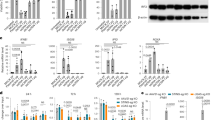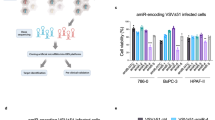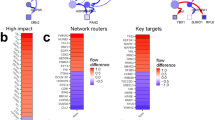Abstract
The role of gap junctional intercellular communication (GJIC) in bystander killing with herpes simplex virus thymidine kinase (HSV-TK) and ganciclovir (GCV) was evaluated in U251 cells expressing a dominant-negative connexin 43 cDNA (DN14), and in HeLa cells, reportedly devoid of connexin protein. These cell lines both exhibited 0% GJIC when assayed by Lucifer Yellow fluorescent dye microinjection. Bystander cytotoxicity was still apparent in 50:50 cocultures of DN14 and HSV-TK-expressing U251 cells, but not in 50:50 cocultures of HeLa cells. However, the sensitivity of HeLa HSV-TK-expressing cells to GCV decreased nearly 100-fold (IC90=109 μM) when cocultured with bystander cells compared to results in 100% cultures of HSV-TK-expressing cells (IC90=1.2 μM). A more sensitive flow cytometry technique to measure GJIC over 24 h revealed that the DN14 and HeLa cells exhibited detectable levels of communication (29 and 23%, respectively). Transfer of phosphorylated GCV to HeLa bystander cells occurred within 4 h after drug addition, and GCV triphosphate (GCVTP) accumulated to 213±84 pmol/106 cells after 24 h. In addition, GCVTP levels were decreased in HSV-TK-expressing cells in coculture (867±33 pmol/106 cells) compared to 100% cultures of HSV-TK-expressing cells (1773±188 pmol/106 cells). The half-life of GCVTP in the HSV-TK-expressing cells was approximately four times that measured in the bystander cells (12.3 and 3.1 h, respectively). These data suggest that the lack of bystander cytotoxicity in HeLa cocultures is due to low transfer of phosphorylated GCV and a rapid half-life of GCVTP in the bystander cells. Thus, GCV phosphate transfer to non-HSV-TK-expressing bystander cells may mediate either bystander cell killing or sparing of HSV-TK-positive cells, depending upon the cell specific drug metabolism.
This is a preview of subscription content, access via your institution
Access options
Subscribe to this journal
Receive 12 print issues and online access
$259.00 per year
only $21.58 per issue
Buy this article
- Purchase on Springer Link
- Instant access to full article PDF
Prices may be subject to local taxes which are calculated during checkout








Similar content being viewed by others
References
Moolten FL . Drug sensitivity (suicide) genes for selective cancer chemotherapy. Cancer Gene Ther 1994; 1: 279–287.
Yazama K, Fisher WE, Brunicardi FC . Current progress in suicide gene therapy for cancer. World J Surg 2002; 26: 783–789.
Greco O, Dachs GU . Gene directed enzyme/prodrug therapy of cancer: historical appraisal and future prospectives. J Cell Physiol 2001; 187: 22–36.
Moolten FL . Tumor chemosensitivity conferred by inserted herpes thymidine kinase genes: paradigm for a prospective cancer control strategy. Cancer Res 1986; 46: 5276–5281.
Culver KW et al. In vivo gene transfer with retroviral vector-producer cells for treatment of experimental brain tumors. Science 1992; 256: 1550–1552.
Shewach DS et al. Enhanced cytotoxicity of antiviral drugs mediated by adenovirus directed transfer of the herpes simplex virus thymidine kinase gene in rat glioma cells. Cancer Gene Ther 1994; 1: 107–112.
Moolten FL, Wells JM . Curability of tumors bearing herpes thymidine kinase genes transferred by retroviral vectors. J Nat Cancer Inst 1990; 82: 297–300.
Boucher PD, Ruch RJ, Shewach DS . Differential ganciclovir-mediated cytotoxicity and bystander killing in human colon carcinoma cell lines expressing herpes simplex virus thymidine kinase. Human Gene Ther 1998; 9: 801–814.
Rubsam LZ, Davidson BL, Shewach DS . Superior cytotoxicity with ganciclovir compared with acyclovir and 1-β-D-arabinofuranosylthymine in herpes simplex virus-thymidine kinase-expressing cells: a novel paradigm for cell killing. Cancer Res 1998; 58: 3873–3882.
Ishii-Morita H et al. Mechanism of ‘bystander effect’ killing in the herpes simplex thymidine kinase gene therapy model of cancer treatment. Gene Therapy 1997; 4: 244–251.
Boucher PD, Ostruszka LJ, Murphy PJ, Shewach DS . Hydroxy-urea significantly enhances tumor growth delay in vivo with herpes simplex virus thymidine kinase/ganciclovir gene therapy. Gene Therapy 2002; 9: 1023–1030.
Smee DF et al. Intracellular metabolism and enzymatic phosphorylation of 9-(1,3-dihydroxy-2-propoxymethyl)guanine and acyclovir in herpes simplex virus-infected and uninfected cells. Biochem Pharmacol 1985; 34: 1049–1056.
Biron KK et al. Metabolic activation of the nucleoside analog 9-{[2-hydroxy-1-(hydroxymethyl)ethoxy]methyl}guanine in human diploid fibroblasts infected with human cytomegalovirus. Proc Nat Acad Sci USA 1985; 82: 2473–2477.
Cheng Y et al. Metabolism of 9-(1,3-dihydroxy-2-propoxymethyl)guanine, a new anti-herpes compound, in herpes simplex virus-infected cells. J Biol Chem 1983; 258: 12460–12464.
Keller PM et al. Enzymatic phosphorylation of acyclic nucleoside analogs and correlations with antiherpetic activities. Biochem Pharmacol 1981; 39: 3071–3077.
Chen MS, Walker J, Prusoff WH . Kinetic studies of herpes simplex virus type 1-encoded thymidine and thymidylate kinase, a multifunctional enzyme. J Biol Chem 1979; 254: 10747–10753.
Boehme RE . Phosphorylation of the antiviral precursor 9-(1,3-dihydroxy-2-propoxymethyl)guanine monophosphate by guanylate kinase isozymes. J Biol Chem 1984; 259: 12346–12349.
Balzarini J, Bohman C, De Clercq E . Differential mechanism of cytostatic effect of (E)-5-(2-bromovinyl)-2′-deoxyuridine, 9-(1,3-dihydroxy-2-propoxymethyl)guanine, and other antiherpetic drugs on tumor cells transfected by the thymidine kinase gene of herpes simplex virus type 1 or type 2. J Biol Chem 1993; 268: 6332–6337.
Ilsley DD, Lee S, Miller WH, Kuchta RD . Acyclic guanosine analogs inhibit DNA polymerase α, δ, ɛ with very different potencies and have unique mechanisms of action. Biochemistry 1995; 34: 2504–2510.
Reardon JE . Herpes simplex virus type 1 and human DNA polymerase interactions with 2′-deoxyguanosine 5′-triphosphate analogs. J Biol Chem 1989; 264: 19039–19044.
Reid R, Mar E, Huang E, Topal MD . Insertion and extension of acyclic, dideoxy, and ara nucleotides by herpesviridae, human α and β polymerases. J Biol Chem 1988; 263: 3898–3904.
Roth JA, Cristiano RJ . Gene therapy for cancer: what have we done and where are we going? J Nat Cancer Ins 1997; 89: 21–39.
Freytag SO et al. Phase I study of replication-competent adenovirus-mediated double suicide gene therapy for the treatment of locally recurrent prostate cancer. Cancer Res 2002; 62: 4968–4976.
Dewey RA et al. Chronic brain inflammation and persistent herpes simplex virus 1 thymidine kinase expression in survivors of syngeneic glioma treated by adenovirus-mediated gene therapy: implications for clinical trials. Nat Med 1999; 5: 1256–1263.
Floeth FW et al. Local inflammation and devascularization – in vivo mechanisms of the ‘bystander effect’ in VPC-mediated HSV-Tk/GCV gene therapy for human malignant glioma. Cancer Gene Ther 2001; 8: 843–851.
Pope IM, Poston GJ, Kinsella AR . The role of the bystander effect in suicide gene therapy. Eur J Cancer 1997; 33: 1005–1016.
Freeman SM et al. The ‘bystander effect’: tumor regression when a fraction of the tumor mass is genetically modified. Cancer Res 1993; 53: 5274–5283.
Princen F et al. A cell type-specific and gap junction-independent mechanism for the herpes simplex virus-1 thymidine kinase gene/ganciclovir-mediated bystander effect. Clin Cancer Res 1999; 5: 3639–3644.
Rubsam LZ et al. Cytotoxicity and accumulation of ganciclovir triphosphate in bystander cells cocultured with herpes simplex virus type 1 thymidine kinase-expressing human glioblastoma cells. Cancer Res 1999; 59: 669–675.
Mesnil M et al. Bystander killing of cancer cells by herpes simplex virus thymidine kinase gene is mediated by connexins. Proc Nat Acad Sci 1996; 93: 1831–1835.
Mesnil M, Yamasaki H . Bystander effect in herpes simplex virus-thymidine kinase/ganciclovir cancer gene therapy: role of gap-junctional intercellular communication. Cancer Res 2000; 60: 3989–3999.
Tanaka T, Yamasaki H, Mesnil M . Stimulation of intercellular communication of poor-communicating cells by gap-junction-competent cells enhances the HSV-TK/GCV bystander effect in vitro. Int J Cancer 2001; 91: 538–542.
Mesnil M, Piccoli C, Yamasaki H . A tumor suppressor gene, Cx26, also mediates the bystander effect in HeLa cells. Cancer Res 1997; 57: 2929–2932.
Touraine RL, Ishii-Morita H, Ramsey WJ, Blaese RM . The bystander effect in the HSVtk/ganciclovir system and its relationship to gap junctional communication. Gene Therapy 1998; 5: 1705–1711.
Asklund T et al. Gap junction-mediated bystander effect in primary cultures of human malignant gliomas with recombinant expression of the HSVtk gene. Exp Cell Res 2003; 284: 185–195.
Imaizumi K et al. Bystander tumoricidal effect and gap junctional communication in lung cancer cell lines. Am J Respiratory Cell Mol Bio 1998; 18: 205–212.
Denning C, Pitts JD . Bystander effects of different enzyme-prodrug systems for cancer gene therapy depend on different pathways for intercellular transfer of toxic metabolites, a factor that will govern clinical choice of appropriate regimes. Human Gene Ther 1997; 8: 1825–1835.
Nicholas TW, Read SB, Burrows FJ, Kruse CA . Suicide gene therapy with herpes simplex virus thymidine kinase and ganciclovir is enhanced with connexins to improve gap junctions and bystander effects. Histol Histopathol 2003; 18: 495–507.
Huang R et al. Connexin 43 (CX43) enhances chemotherapy-induced apoptosis in human glioblastoma cells. Int J Cancer 2001; 92: 130–138.
Goodenough DA, Goliger JA, Paul DL . Connexins, connexons, and intercellular communication. Annu Rev Biochem 1996; 65: 475–502.
Simon AM, Goodenough DA . Diverse functions of vertebrate gap junctions. Trends Cell Biol 1998; 8: 477–483.
Yeager M, Nicholson BJ . Structure of gap junction intercellular channels. Curr Opin Struct Biol 1996; 6: 183–192.
Ahmad S, Martin PEM, Evans WH . Assembly of gap junction channels. Eur J Biochem 2001; 268: 4544–4552.
Boucher PD, Ostruszka LJ, Shewach DS . Synergistic enhancement of herpes simplex virus thymidine kinase/ganciclovir-mediated cytotoxicity by hydroxyurea. Cancer Res 2000; 60: 1631–1636.
Krutovskikh VA, Yamasaki H, Asamoto M . Inhibition of intrinsic gap-junction intercellular communication and enhancement of tumorigenicity of the rat bladder carcinoma cell line BC31 by a dominant-negative connexin 43 mutant. Mol Carcinogen 1998; 23: 254–261.
Tomasetto C et al. Specificity of gap junction communication among human mammary cells and connexin transfectants in culture. J Cell Biol 1993; 122: 157–167.
Ruch RJ et al. Loss of gap junctions from DDT-treated rat liver epithelial cells. Carcinogenesis 1994; 15: 301–306.
Czyz J et al. Gap-junctional coupling measured by flow cytometry. Exp Cell Res 2000; 255: 40–46.
King TJ et al. Correlation between growth control, neoplastic potential and endogenous connexin43 expression in HeLa cell lines: implications for tumor progression. Carcinogenesis 2000; 21: 311–315.
Wygoda MR et al. Protection of herpes simplex virus thymidine kinase-transduced cells from ganciclovir-mediated cytotoxicity by bystander cells. Cancer Res 1997; 57: 1699–1703.
Tsien RY . A non-disruptive technique for loading calcium buffers and indicators into cells. Nature 1981; 290: 527–528.
Oh DJ, Lee GM, Francis K, Palsson BO . Phototoxicity of the fluorescent membrane dyes PKH2 and PKH26 on the human hematopoietic KG1a progenitor cell line. Cytometry 1999; 36: 312–318.
Acknowledgements
This work was supported in part by the Pharmaceutical Science Training Program, Grant GM07767 from the National Institute of General Medical Sciences (NIGMS), Grant CA76581 from the NIH, and the University of Michigan Core Flow Cytometry Facility.
Author information
Authors and Affiliations
Rights and permissions
About this article
Cite this article
Gentry, B., Im, M., Boucher, P. et al. GCV phosphates are transferred between HeLa cells despite lack of bystander cytotoxicity. Gene Ther 12, 1033–1041 (2005). https://doi.org/10.1038/sj.gt.3302487
Received:
Accepted:
Published:
Issue Date:
DOI: https://doi.org/10.1038/sj.gt.3302487
Keywords
This article is cited by
-
MLH1 deficiency enhances tumor cell sensitivity to ganciclovir
Cancer Gene Therapy (2009)
-
Bortezomib-induced enzyme-targeted radiation therapy in herpesvirus-associated tumors
Nature Medicine (2008)



